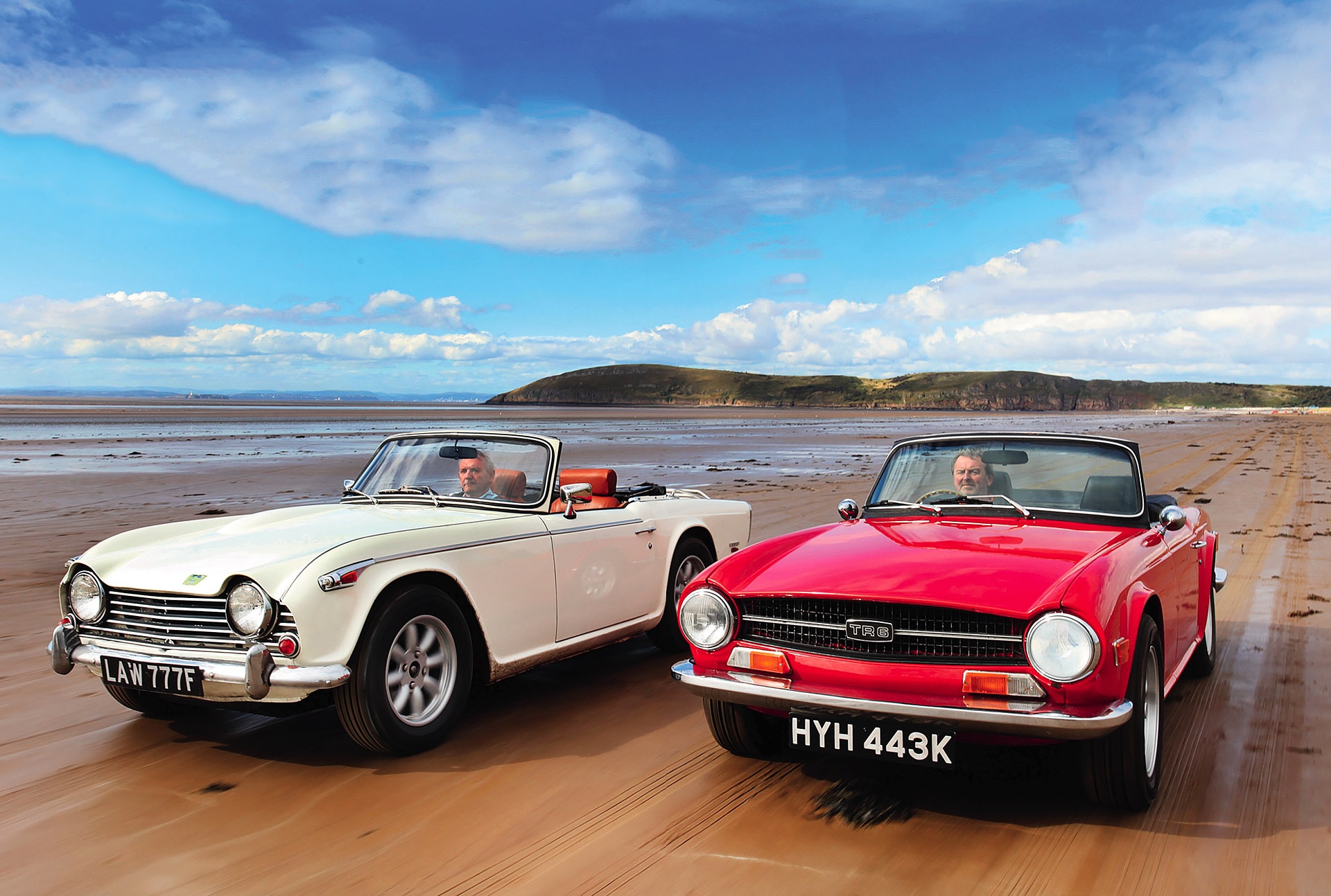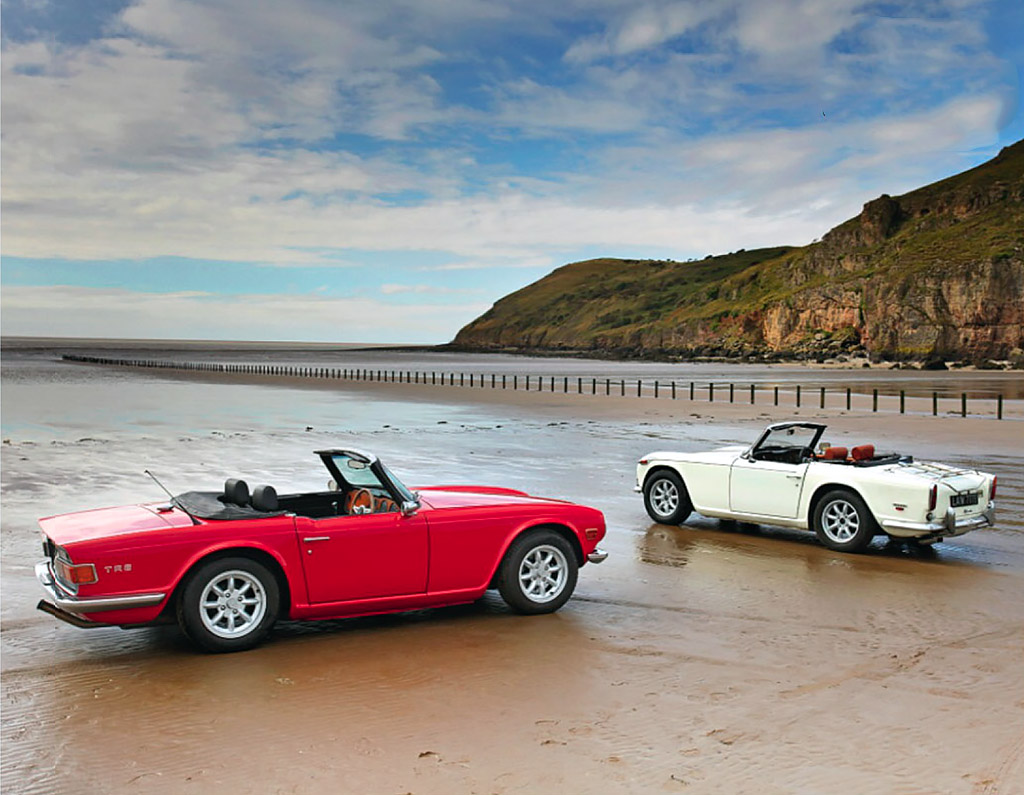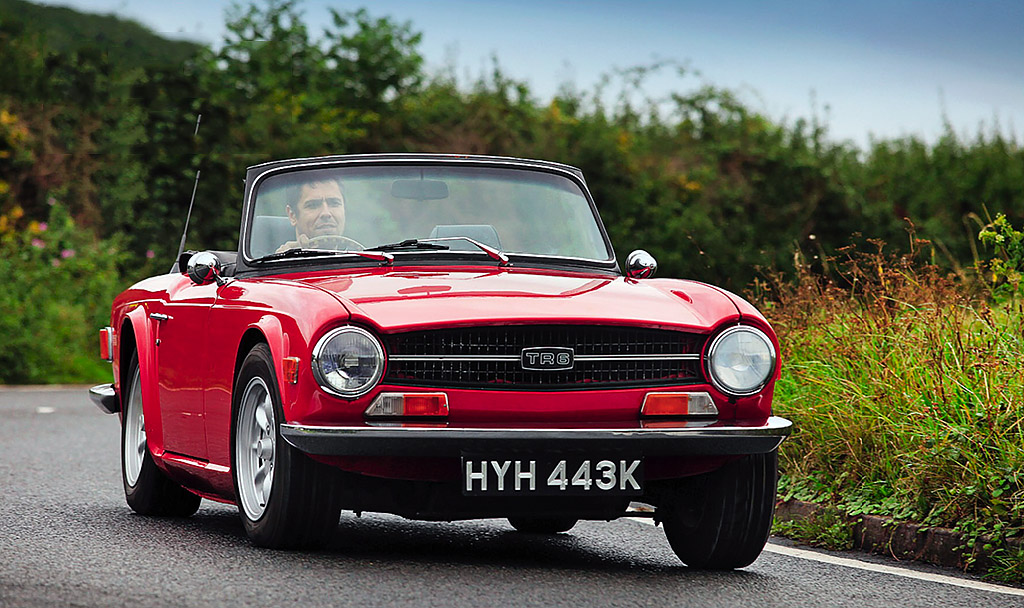
Triumph TR5 vs TR6 – two cars identical in every way except how they look… and what they cost. Family Feud. Triumph gave the TR series a new lease of life on a budget, thanks to a clever Karmann nip and tuck. But does Ross Alkureishi prefer 5 or 6? Photography James Mann.
It’s human nature to stride forwards, push the barriers and strive for something new. In Christianity, the Tenth Commandment states: ‘Thou shalt not covet…’ And while it’s easy, for most of us, to apply that while admiring a neigh-bour’s treasured garden gnomes, it’s harder in other avenues of modern day life. Consumerism, and all it involves, flies in its face and car makers play on that fact. It’s why we’re happy to discard our current model and pay significant premiums for a new numberplate, mild restyle and 3bhp increase – thanks to that clever Engine Control Unit modification. Call it the unwritten rule of automotive desire.

Cleaner lines of TR6, with less brightwork, cleverly modernised the TR for a new decade. Minilite-style rims are a popular fitment.
This is nothing new, though. Car firms, especially those that operated close to – or on – the breadline, have always found innovative ways of making their products seem box-fresh and super appealing. In Triumph’s case, as it pondered the fate of its stop-gap TR5 – and unable to finance a new model – it employed German manufacturer Karmann to work its deft magic on the outgoing vehicle, to create the TR6.
“You really have to applaud the designers for what appears to be a radically different car,” says Neil Revington, of specialist Revington TR. “Given that they’re almost identical.”
With that in mind, given the vast price difference, there’s only one question to answer: should it be 5 or 6, to get your six-cylinder Triumph Roadster kicks? The Standard- triumph TR came into being thanks in part to the successes of its rivals. Chairman Sir John Black watched as cheap MGs flooded the burgeoning US market, before William Lyons’ Jaguar-with its stylish, rapid XKs – claimed its place at the top of the pile. Coupled with disappointment at a failed bid to take over the Morgan Motor Co, Black set his sights on taking a share. Stylist Walter Belgrove and engineer Harry Webster were set the unenviable task of delivering a cheap and simple sports car, capable of high performance, yet to be built from a mechanical swap-shop of current saloon car components. Oh, and it all had to be done on a negligible development budget.
The 20TS (for Triumph Sports), which made its debut at the 1952 London Motor Show, was well received. With anticipated 100mph-plus performance from its 1991cc four-cylinder Standard Vanguard/Ferguson tractor-derived engine, it could hold its own with the curvaceous Austin-Healey 100, which was also unveiled at the show. Restrictions in the body-tooling funds meant that all panels were limited to single curvature, something that was apparent if you placed them side-by-side, although crucially it undercut the Healey’s price by a whopping £200.

Neat Karmann restyle makes TR6 look longer although there’s only an inch difference; central section is the same.
But die designers knew that it required further work. Racing car engineer Ken Richardson was invited to test the Triumph and voiced reservations. Black promptly hired him to rework it and, in just two months, he and his team delivered on the performance front. Two years later, and a year after launch – with production cars rechristened the TR2 (for Triumph Roadster) – it won the RAC Rally, and the legend of the rugged TR was born. In 1955, it morphed – unsurprisingly, with minimal development costs-into the TR3, with an egg-crate grille mounted to the fore, a small power hike and, from 1956, front disc brakes – a first for a mass-produced British model.
The first real monetary boost arrived when Giovanni Michelotti was commissioned to bring the TR up to date, with the TR4. His sensuous modem take on the Roadster idea – on basically the same chassis – was well received. It featured rack steering plus an innovative steel hardtop with removable central panel and a handy Surrey cloth mid-section. US importers were worried by its higher price, though, so the factory built left-hand-drive TR3 B.
But it’s the 1965 TR4A that is the TR5’s direct descendant, because this was the first to feature the same bell-shaped chassis that housed the new coil-sprung, independent rear suspension. Developed, as ever, as cheaply as possible, it proved successful in giving a much-improved ride and enhanced handling.

By then, though, the car’s combination of increased weight and four-cylinder engine was no longer providing the necessary go for that sublime exterior show. The answer came with a derivation of the Triumph 2-litre ‘six’ – first seen in the Standard Vanguard and then the Triumph 2000. The updated block had a longer stroke, displacing 2498cc, and was paired with a new camshaft, plus updated conrods and pistons and, in a first for a British production car, fuel injection by Lucas. Minimal styling changes kept costs low, while servo-assisted brakes complemented the TR5 FI’s power output of a claimed 150bhp. The fastest ever TR had arrived.
The overwhelming approval of its TR4 sibling’s profile meant that the identically bodied 5 already started on the up. Autosport praised it as ‘a car of exciting appearance and sporting lines’ and, sitting here on the golden sand of Brean Down beach in Somerset, there’s no denying that the profile is the most alluring of the TR range. Michelotti’s shape is elegant, with just the right hint of muscularity from subtly flared arches and a bonnet that combines a single long bulge – no longer needed to clear the carbs – and ‘eyelids’ covering the top of the headlights. Meanwhile frameless windows work towards an overall impression of a clean, uncluttered form.
This feeling continues inside the cabin, with a simple arrangement of Smiths gauges set, here, in an aftermarket burr-walnut dash. The driving position is offset slightly, with pedals to the right, but this car’s bucket seats lend more lateral support, albeit a little further reclined than in one of the original items. It’s still a relatively tight space, but it’s positively capacious compared to ‘sidescreen’ TRs and has decent ergonomics.

Fire up that eager straight-six and its rugged character is revealed in an instant; it sounds pleasantly gruff at take-off and low speeds, but heavier throttle pressure pushes it to a fierce howl at full tilt. Acceleration is undeniably lively, with effortless torque throughout the rev range; this is thanks to a fairly wild camshaft that Triumph successfully tamed by using injection.
Often referred to as a ‘hairy-chested’ sports car, which it undoubtedly is, the TR5’s overdrive unit also means it’s multi-faceted. A flick of the column lever cuts engine speed by 500qmi and then the choice is yours: spirited driving under heavy throttle; matching speed to traffic conditions right on cam; or slowing the frenetic pace to reveal a gentler, friendlier persona and one that’s ideal for long-distance touring.
TheTR5’s perfect blend of style, open-topped driving pleasure and raw performance surely means that our Triumph Roadster journey should be at an end? Well, yes, but – and it’s a large but – you could have the same car for £20,000 less. Okay, the same, but different. Same mechanicals. Same interior. Same performance. Different (ish) body. And, if anything, with a fuel- injection system that had the benefit of further refinement. Interest piqued? Enter the TR6.
Despite merging with one-time rivals MG, Jaguar and Austin-Healey to form British Leyland in 1968, Triumph’s brave new world didn’t result in the liberation of any increase in development funds. Once again, the evolution of the dated-lookingTR5 was to be conducted on a shoestring budget. With Michelotti engaged elsewhere, in stepped Karmann to carry out what was essentially a low-cost face – and tail-lift. That it completed the job in just 14 months was incredible, especially given the new conglomerate’s propensity for death-by-committee, and the need to build the necessary manufacturing tooling in iiber-quick time.
“The only differences are from front wheel-arch forward, and rear arch backwards,” says Revington. “The central part of the car remains the same; it retains the TR5’s floor, scuttle, windscreen, doors and inner panels.” With a simpler front – sans power bulge, and yet more assertive – and Kamm-like truncated rear, it was a masterstroke. Designer Gerhard Gieseke had pulled off a sleight of hand magician David Nixon would have been proud of, and all without the aid of Chroma Key special effects.
The contemporary fashion of matt black as the ‘new’ brightwork also helped to give the latest model its own distinct identity. The radiator grille and rear panel were finished in black, irrespective of the principal chosen colour of the car.
The TR6 looks more sober, alongside the TR5’s twinkle-eyed mischievousness.
Sitting side-by-side the 6 looks much longer, although it’s a trick on the eye caused by the flat bonnet, and in reality it has only an extra inch over the 5 – but still enough to usefully increase boot capacity from 5.1 to 6cu ft. Both have that same slender snake-hipped central section, but from the front the TR6 looks the more sober of the two designs – like the austere chaperone to the 5’s twinkle-eyed mischievousness. The TR5’s rear-light arrangement is more pleasing than its sibling’s wraparound affairs, but that Matt Black Kamm-type tail is stunning. When you follow a TR6, it gives it real road presence – and the merest hint of Alfa TZ, albeit somewhat accentuated on this red example.
The cabin is instantly familiar, although its narrow feel must, by then, have felt of a different age compared to more spacious period rivals such as the Fiat 124 Spider.
There were new seats, with perforations in their Ambla plastic trim, to help keep you cool as you made the most of the handling. That said, the weighty low-speed steering soon lightens. But, like the TR5 here, the featured example sports modern seats, although, unlike the 5, it retains its original American walnut dash, rather than a burr-walnut replacement.
Aside from a new 11/16 in anti-roll bar at the front, under the skin early 6s such as this one are identical to their predecessor. So, on the hoof it’s basically the same experience: hefty clutch and notchy but positive gearchange, strong brakes and, of course, that majestically gruff powerplant sitting at the heart of things. Like the 5, it has very good roadholding, but the addition to the front suspension only really makes itself known at the edge of hard cornering, where it reduces the tendency to rapidly flip from understeer to oversteer if you lift off the throttle. One downside of Karmann’s quick turnaround is an increased bulk of 205lb, but on the road it feels only marginally slower than its older sibling.
This didn’t bother Autocar, which, still lamenting the demise of the Big Healey in 1968, praised the TR6 both for its fresh new aesthetics and familiarly brawny driving experience: ‘It is very much a masculine machine, calling for beefy muscles, bold decisions and even ruthlessness on occasions. It could be dubbed the last of the real sports cars… and is tremendously exhilarating to drive anywhere.’
Others, including Car and Driver; suggested you leave your preconceptions behind the moment you open the TR6’s door, and simply enjoy it as the last of the true British sports cars.
So, back to the original question: 5 or 6? There are another couple of key considerations first, says Revington: “The most important thing about these cars is the fuel injection; it can be what makes one good, but also what makes one terrible, as well.” The Lucas system, which drew petrol from the tank through a paper element filter by means of a motor-driven pump, quickly gained a reputation for being unreliable.
As Revington puts it: “Early TR5s in essence had development fuel injection, but by the late examples and early TR6s – both designated CP – they were nearly there. The filter housing was also used as a swirl pot, to ensure that you didn’t run out of puff going round comers. This Lucas CAV diesel-filter arrangement had an aluminium tube running down to the bottom to pick up fuel, but looked identical to the standard filters that didn’t. The problems occurred when owners changed the original items for these, a trivial mistake but one that could make or break performance by causing fuel starvation.”
The other question is power. In 1973, the later – CR – unit received a milder camshaft; this lent the engine greater flexibility. But, with a recalculated power output of 124bhp, they’re sometimes looked down on against the 150bhp CP cars.
“Apples and pears,” says Revington. “CP cars were tested to SAE specifications, which stated 150bhp but was often considerably less – the reality is usually 135-138bhp. CR cars were tested to DIN regulations, at 124bhp but usually better at around 130bhp. So the difference can be as little as 5-8bhp. Triumph also put a dedicated swirl pot in the fuel tank, to avoid problems caused by owner tinkering. All cars originally had a Lucas fuel pump, but these days we fit a Bosch unit that works properly and avoids the need to stop and buy a bag of frozen peas to hold round it until it has cooled down.”
We’re doubly lucky in the classic car world. We can revisit the past and right design wrongs, but more importantly modify that unwritten rule of automotive desire. With the benefit of hindsight, that fickle march of fashion can be reversed – with die newer model not necessarily being the one that we covet.
There’s no doubt that the TR5 is the prettier of our two cars but, despite my love of its brooding front profile, it’s a simple question of economics for me. At this current point in my life, if I was looking to buy, the 6 is in my price range and the 5 isn’t. So 141 plump for an early CP TR6 – with the same torque output – and, suitably armed with that knowledge, drive it to ensure that it’s been properly sorted, then content myself with the fact that I’m getting exactly the same driving experience for up to half the price. Oh, and I’d always park it nose first, so I could admire that beautifully clean-cut rear every time I walked towards it.
Thanks to Nick and Dove Morgan; Revington
|
TRIUMPH TR5 Sold/number built 1967-1968/2947 Construction steel chassis, steel body Engine all-iron, overhead-valve 2498cc six with Lucas mechanical fuel injection Max power 150bhp @ 5500rpm (CP) Max torque 164lb ft @ 3500rpm (CP) Transmission four-speed manual (with optional overdrive), driving rear wheels Suspension: front double wishbones, telescopies rear semi-trailing arms, lever-arms; coils f/r Steering rack and pinion Brakes discs front/drums rear, with servo Length 12ft 11 ½ in (3949mm) Width 5ft 1in (1549mm) Height 4ft 2in (1270mm) Wheelbase 7ft 4in (2235mm) Weight 2268lb (1029kg) Mpg 20 0-60mph 8.1 secs Top speed 120mph Price new £1212 Now from £20,000 |
TRIUMPH TR6 (where different) Sold/number built 1969-1976/94,619 Max power 124bhp @ 5000rpm (CR) Max torque 143lb ft @ 3500rpm (CR) Transmission o/d standard from 1973 Suspension: front anti-roll bar Length 13ft ½ in (3975mm) Weight 2473lb (1122kg) 0-60mph 8.2 secs (9.1 secs CR) Top speed 119mph Mpg 21 Price new £1334 Now from £10,000 |
{CONTENTPOLL [“id”: 7]}
THE SPECIALIST
Revington TR
“In terms of value against what it costs to repair, body and chassis are the main areas to check,” advises Neil Revington. “But the cost of changing the chassis – at £3500, plus labour – is miniscule compared to dealing with rotten bodywork, so check panel condition carefully. Later CR TR6s are likely to have better chassis.
“Engines are robust but have one malady: unlike the TR4 unit, they only have half a thrust washer either side of the main bearing cap; the latter holds the former in place, but, as wear occurs, the thrust washers can come loose and end up in the sump. That means a new block, or serious machining to rectify. Check by using a soft lever between crank pulley and block, if there’s significant movement, then its already happened.
”TR5s and CP 6s have A-type overdrives, while the CR 6’s J-type is more reliable. If it makes a ‘shushing’ noise, then the layshaft bearings are probably knackered, which means a recon or you can fit a Toyota Celica five-speed ‘box, but you lose the flexibility of the overdrive. Unlike the originals, however, they don’t have to be whipped out every 20,000 miles and reconditioned.
“Values differ hugely: the best TR6s are £25-30,000, perhaps a little more, but for the TR5 you’re looking at £45-50,000, yet decent driveable cars can be had for a lot less. For both, there’s little that you can’t get or fix, and specialists have cured any original flaws to make them very reliable.”
Left, from top: badge for overdrive and PI; sidelight cum-repeater was carried over from TR4A; mostly aftermarket cabin but bucket seats and chunky wheel feel sportier than factory items; eager ‘six’.
Clockwise: you only notice the TR6’s front anti-roll bar when pressing on; timber dashboard is the original but Moto-Lita is a later fitment; matt black Kamm tail emphasises chunky rear light cluster.





